Computational Modeling of Flexoelectricity—A Review
Abstract
1. Introduction
2. Ground Work Formulation
2.1. Physical Variational Principle
2.2. Alternative Formulation
3. Computational Modeling
3.1. Meshfree Method
3.2. Mixed Finite Element Method
3.3. IGA Approach
3.4. Implementations
Mixed FEM
3.5. IGA Approach
4. Numerical Examples
4.1. Hollow Cylinder
4.2. Cantilever Beam
4.3. Truncated Pyramid
5. Discussion
Author Contributions
Funding
Acknowledgments
Conflicts of Interest
Appendix A. Second-Order Derivative of NURBS Basis Functions
References
- Tolpygo, K. Long wavelength oscillations of diamond-type crystals including long range forces. Sov. Phys.-Solid State 1963, 4, 1297–1305. [Google Scholar]
- Kogan, S.M. Piezoelectric effect during inhomogeneous deformation and acoustic scattering of carriers in crystals. Sov. Phys.-Solid State 1964, 5, 2069–2070. [Google Scholar]
- Huang, W.; Yan, X.; Kwon, S.R.; Zhang, S.; Yuan, F.G.; Jiang, X. Flexoelectric strain gradient detection using Ba0. 64Sr0. 36TiO3 for sensing. Appl. Phys. Lett. 2012, 101, 252903. [Google Scholar] [CrossRef]
- Kwon, S.R.; Huang, W.; Zhang, S.; Yuan, F.G.; Jiang, X. Study on a flexoelectric microphone using barium strontium titanate. J. Micromech. Microeng. 2016, 26, 045001. [Google Scholar] [CrossRef]
- Merupo, V.I.; Guiffard, B.; Seveno, R.; Tabellout, M.; Kassiba, A. Flexoelectric response in soft polyurethane films and their use for large curvature sensing. J. Appl. Phys. 2017, 122, 144101. [Google Scholar] [CrossRef]
- Bhaskar, U.K.; Banerjee, N.; Abdollahi, A.; Wang, Z.; Schlom, D.G.; Rijnders, G.; Catalan, G. A flexoelectric microelectromechanical system on silicon. Nat. Nanotechnol. 2016, 11, 263. [Google Scholar] [CrossRef]
- Zhang, S.; Liu, K.; Xu, M.; Shen, S. A curved resonant flexoelectric actuator. Appl. Phys. Lett. 2017, 111, 082904. [Google Scholar] [CrossRef]
- Rey, A.D.; Servio, P.; Herrera-Valencia, E. Bioinspired model of mechanical energy harvesting based on flexoelectric membranes. Phys. Rev. E 2013, 87, 022505. [Google Scholar] [CrossRef]
- Jiang, X.; Huang, W.; Zhang, S. Flexoelectric nano-generator: Materials, structures and devices. Nano Energy 2013, 2, 1079–1092. [Google Scholar] [CrossRef]
- Deng, Q.; Kammoun, M.; Erturk, A.; Sharma, P. Nanoscale flexoelectric energy harvesting. Int. J. Solids Struct. 2014, 51, 3218–3225. [Google Scholar] [CrossRef]
- Choi, S.B.; Kim, G.W. Measurement of flexoelectric response in polyvinylidene fluoride films for piezoelectric vibration energy harvesters. J. Phys. D Appl. Phys. 2017, 50, 075502. [Google Scholar] [CrossRef]
- Liang, X.; Hu, S.; Shen, S. Nanoscale mechanical energy harvesting using piezoelectricity and flexoelectricity. Smart Mater. Struct. 2017, 26, 035050. [Google Scholar] [CrossRef]
- Zhu, R.; Wang, Z.; Ma, H.; Yuan, G.; Wang, F.; Cheng, Z.; Kimura, H. Poling-free energy harvesters based on robust self-poled ferroelectric fibers. Nano Energy 2018, 50, 97–105. [Google Scholar] [CrossRef]
- Lu, H.; Bark, C.W.; De Los Ojos, D.E.; Alcala, J.; Eom, C.B.; Catalan, G.; Gruverman, A. Mechanical writing of ferroelectric polarization. Science 2012, 336, 59–61. [Google Scholar] [CrossRef] [PubMed]
- Lu, H.; Liu, S.; Ye, Z.; Yasui, S.; Funakubo, H.; Rappe, A.M.; Gruverman, A. Asymmetry in mechanical polarization switching. Appl. Phys. Lett. 2017, 110, 222903. [Google Scholar] [CrossRef]
- Guo, R.; Shen, L.; Wang, H.; Lim, Z.; Lu, W.; Yang, P.; Gruverman, A.; Venkatesan, T.; Feng, Y.P.; Chen, J. Tailoring Self-Polarization of BaTiO3 Thin Films by Interface Engineering and Flexoelectric Effect. Adv. Mater. Interfaces 2016, 3, 1600737. [Google Scholar] [CrossRef]
- Yang, M.M.; Kim, D.J.; Alexe, M. Flexo-photovoltaic effect. Science 2018, 360, 904–907. [Google Scholar] [CrossRef]
- Liu, Y.; Chen, J.; Deng, H.; Hu, G.; Zhu, D.; Dai, N. Anomalous thermoelectricity in strained Bi 2 Te 3 films. Sci. Rep. 2016, 6, 32661. [Google Scholar] [CrossRef]
- Nguyen, T.D.; Mao, S.; Yeh, Y.W.; Purohit, P.K.; McAlpine, M.C. Nanoscale flexoelectricity. Adv. Mater. 2013, 25, 946–974. [Google Scholar] [CrossRef]
- Zubko, P.; Catalan, G.; Tagantsev, A.K. Flexoelectric effect in solids. Annu. Rev. Mater. Res. 2013, 43. [Google Scholar] [CrossRef]
- Yudin, P.; Tagantsev, A. Fundamentals of flexoelectricity in solids. Nanotechnology 2013, 24, 432001. [Google Scholar] [CrossRef] [PubMed]
- Krichen, S.; Sharma, P. Flexoelectricity: A perspective on an unusual electromechanical coupling. J. Appl. Mech. 2016, 83, 030801. [Google Scholar] [CrossRef]
- Maranganti, R.; Sharma, N.; Sharma, P. Electromechanical coupling in nonpiezoelectric materials due to nanoscale nonlocal size effects: Green’s function solutions and embedded inclusions. Phys. Rev. B 2006, 74, 014110. [Google Scholar] [CrossRef]
- Mindlin, R.D. Polarization gradient in elastic dielectrics. Int. J. Solids Struct. 1968, 4, 637–642. [Google Scholar] [CrossRef]
- Sahin, E.; Dost, S. A strain-gradients theory of elastic dielectrics with spatial dispersion. Int. J. Eng. Sci. 1988, 26, 1231–1245. [Google Scholar] [CrossRef]
- Majdoub, M.; Sharma, P.; Çağin, T. Dramatic enhancement in energy harvesting for a narrow range of dimensions in piezoelectric nanostructures. Phys. Rev. B 2008, 78, 121407. [Google Scholar] [CrossRef]
- Majdoub, M.; Sharma, P.; Çağin, T. Erratum: Dramatic enhancement in energy harvesting for a narrow range of dimensions in piezoelectric nanostructures [Phys. Rev. B 78, 121407 (R)(2008)]. Phys. Rev. B 2009, 79, 159901. [Google Scholar] [CrossRef]
- Majdoub, M.; Sharma, P.; Cagin, T. Enhanced size-dependent piezoelectricity and elasticity in nanostructures due to the flexoelectric effect. Phys. Rev. B 2008, 77, 125424. [Google Scholar] [CrossRef]
- Majdoub, M.S.; Sharma, P.; Çağin, T. Erratum: Enhanced size-dependent piezoelectricity and elasticity in nanostructures due to the flexoelectric effect [Phys. Rev. B77, 125424 (2008)]. Phys. Rev. B 2009, 79. [Google Scholar] [CrossRef]
- Sharma, N.; Landis, C.; Sharma, P. Piezoelectric thin-film superlattices without using piezoelectric materials. J. Appl. Phys. 2010, 108, 024304. [Google Scholar] [CrossRef]
- Hu, S.; Shen, S. Variational principles and governing equations in nano-dielectrics with the flexoelectric effect. Sci. China Physics, Mech. Astron. 2010, 53, 1497–1504. [Google Scholar] [CrossRef]
- Kuang, Z.B. Some problems in electrostrictive and magnetostrictive materials. Acta Mech. Solida Sin. 2007, 20, 219–227. [Google Scholar] [CrossRef]
- Kuang, Z. Some variational principles in electroelastic media under finite deformation. Sci. China Ser. Physics, Mech. Astron. 2008, 51, 1390–1402. [Google Scholar] [CrossRef]
- Kuang, Z.b. Internal energy variational principles and governing equations in electroelastic analysis. Int. J. Solids Struct. 2009, 46, 902–911. [Google Scholar] [CrossRef][Green Version]
- Kuang, Z.B. Theory Electroelasticity; Springer: Berlin/Heidelberg, Germany, 2014. [Google Scholar]
- Liu, L. On energy formulations of electrostatics for continuum media. J. Mech. Phys. Solids 2013, 61, 968–990. [Google Scholar] [CrossRef]
- Liu, L. An energy formulation of continuum magneto-electro-elasticity with applications. J. Mech. Phys. Solids 2014, 63, 451–480. [Google Scholar] [CrossRef]
- Abdollahi, A.; Peco, C.; Millan, D.; Arroyo, M.; Arias, I. Computational evaluation of the flexoelectric effect in dielectric solids. J. Appl. Phys. 2014, 116, 093502. [Google Scholar] [CrossRef]
- Mao, S.; Purohit, P.K.; Aravas, N. Mixed finite-element formulations in piezoelectricity and flexoelectricity. Proc. R. Soc. A 2016, 472, 20150879. [Google Scholar] [CrossRef]
- Deng, F.; Deng, Q.; Yu, W.; Shen, S. Mixed Finite Elements for Flexoelectric Solids. J. Appl. Mech. 2017, 84, 081004. [Google Scholar] [CrossRef]
- Ghasemi, H.; Park, H.S.; Rabczuk, T. A level-set based IGA formulation for topology optimization of flexoelectric materials. Comput. Methods Appl. Mech. Eng. 2017, 313, 239–258. [Google Scholar] [CrossRef]
- Thai, T.Q.; Rabczuk, T.; Zhuang, X. A large deformation isogeometric approach for flexoelectricity and soft materials. Comput. Methods Appl. Mech. Eng. 2018, 341, 718–739. [Google Scholar] [CrossRef]
- Nguyen, B.; Zhuang, X.; Rabczuk, T. Numerical model for the characterization of Maxwell-Wagner relaxation in piezoelectric and flexoelectric composite material. Comput. Struct. 2018, 208, 75–91. [Google Scholar] [CrossRef]
- Nguyen, B.; Zhuang, X.; Rabczuk, T. NURBS-based formulation for nonlinear electro-gradient elasticity in semiconductors. Comput. Methods Appl. Mech. Eng. 2019, 346, 1074–1095. [Google Scholar] [CrossRef]
- Yvonnet, J.; Liu, L. A numerical framework for modeling flexoelectricity and Maxwell stress in soft dielectrics at finite strains. Comput. Methods Appl. Mech. Eng. 2017, 313, 450–482. [Google Scholar] [CrossRef]
- Codony, D.; Marco, O.; Fernández-Méndez, S.; Arias, I. An Immersed Boundary Hierarchical B-spline method for flexoelectricity. arXiv 2019, arXiv:1902.02567. [Google Scholar] [CrossRef]
- Roy, P.; Roy, D. Peridynamics model for flexoelectricity and damage. Appl. Math. Model. 2019, 68, 82–112. [Google Scholar] [CrossRef]
- Toupin, R.A. The elastic dielectric. J. Ration. Mech. Anal. 1956, 5, 849–915. [Google Scholar] [CrossRef]
- Mindlin, R.D.; Eshel, N. On first strain-gradient theories in linear elasticity. Int. J. Solids Struct. 1968, 4, 109–124. [Google Scholar] [CrossRef]
- Abdollahi, A.; Millán, D.; Peco, C.; Arroyo, M.; Arias, I. Revisiting pyramid compression to quantify flexoelectricity: A three-dimensional simulation study. Phys. Rev. B 2015, 91, 104103. [Google Scholar] [CrossRef]
- Abdollahi, A.; Domingo, N.; Arias, I.; Catalan, G. Converse flexoelectricity yields large piezoresponse force microscopy signals in non-piezoelectric materials. Nat. Commun. 2019, 10, 1266. [Google Scholar] [CrossRef]
- He, B.; Javvaji, B.; Zhuang, X. Characterizing Flexoelectricity in Composite Material Using the Element-Free Galerkin Method. Energies 2019, 12, 271. [Google Scholar] [CrossRef]
- Liu, G.R. Meshfree Methods: Moving Beyond the Finite Element Method; CRC Press: Boca Raton, FL, USA, 2009. [Google Scholar]
- Cordes, L.; Moran, B. Treatment of material discontinuity in the element-free Galerkin method. Comput. Methods Appl. Mech. Eng. 1996, 139, 75–89. [Google Scholar] [CrossRef]
- Krongauz, Y.; Belytschko, T. EFG approximation with discontinuous derivatives. Int. J. Numer. Methods Eng. 1998, 41, 1215–1233. [Google Scholar] [CrossRef]
- Nanthakumar, S.; Zhuang, X.; Park, H.S.; Rabczuk, T. Topology optimization of flexoelectric structures. J. Mech. Phys. Solids 2017, 105, 217–234. [Google Scholar] [CrossRef]
- Deng, F.; Deng, Q.; Shen, S. A three-dimensional mixed finite element for flexoelectricity. J. Appl. Mech. 2018, 85, 031009. [Google Scholar] [CrossRef]
- Les Piegl, W.T. The NURBS Book; Springer: Berlin/Heidelberg, Germany, 1997. [Google Scholar]
- Cottrell, J.; Hughes, T.; Bazilevs, Y. Isogeometric Analysis: Toward Integration of CAD and FEA; John Wiley & Sons Inc.: Hoboken, NJ, USA, 2009. [Google Scholar]
- Camacho, G.T.; Ortiz, M. Computational modelling of impact damage in brittle materials. Int. J. Solids Struct. 1996, 33, 2899–2938. [Google Scholar] [CrossRef]
- Schrefler, B.A.; Secchi, S.; Simoni, L. On adaptive refinement techniques in multi-field problems including cohesive fracture. Comput. Methods Appl. Mech. Eng. 2006, 195, 444–461. [Google Scholar] [CrossRef]
- de Borst, R. Fluid flow in fractured and fracturing porous media: A unified view. Mech. Res. Commun. 2017, 80, 47–57. [Google Scholar] [CrossRef]
- Sukumar, N.; Chopp, D.L.; Moës, N.; Belytschko, T. Modeling holes and inclusions by level sets in the extended finite-element method. Comput. Methods Appl. Mech. Eng. 2001, 190, 6183–6200. [Google Scholar] [CrossRef]
- Sukumar, N.; Huang, Z.; Prévost, J.H.; Suo, Z. Partition of unity enrichment for bimaterial interface cracks. Int. J. Numer. Methods Eng. 2004, 59, 1075–1102. [Google Scholar] [CrossRef]
- Shu, J.Y.; King, W.E.; Fleck, N.A. Finite elements for materials with strain gradient effects. Int. J. Numer. Methods Eng. 1999, 44, 373–391. [Google Scholar] [CrossRef]
- Soh, A.K.; Wanji, C. Finite element formulations of strain gradient theory for microstructures and the C0–1 patch test. Int. J. Numer. Methods Eng. 2004, 61, 433–454. [Google Scholar] [CrossRef]
- Gu, S.; He, Q.C. Interfacial discontinuity relations for coupled multifield phenomena and their application to the modeling of thin interphases as imperfect interfaces. J. Mech. Phys. Solids 2011, 59, 1413–1426. [Google Scholar] [CrossRef]
- Liu, J.T.; He, B.; Gu, S.T.; He, Q.C. Implementation of a physics-based general elastic imperfect interface model in the XFEM and LSM context. Int. J. Numer. Methods Eng. 2018, 115, 1499–1525. [Google Scholar] [CrossRef]
- Nguyen, V.P.; Anitescu, C.; Bordas, S.P.; Rabczuk, T. Isogeometric analysis: An overview and computer implementation aspects. Math. Comput. Simul. 2015, 117, 89–116. [Google Scholar] [CrossRef]
- Fischer, P.; Klassen, M.; Mergheim, J.; Steinmann, P.; Müller, R. Isogeometric analysis of 2D gradient elasticity. Comput. Mech. 2011, 47, 325–334. [Google Scholar] [CrossRef]
- Shu, L.; Wei, X.; Pang, T.; Yao, X.; Wang, C. Symmetry of flexoelectric coefficients in crystalline medium. J. Appl. Phys. 2011, 110, 104106. [Google Scholar] [CrossRef]
- Le Quang, H.; He, Q.C. The number and types of all possible rotational symmetries for flexoelectric tensors. Proc. R. Soc. Lond. A Math. Phys. Eng. Sci. 2011, 467, 2369–2386. [Google Scholar] [CrossRef]
- Hong, J.; Vanderbilt, D. First-principles theory and calculation of flexoelectricity. Phys. Rev. B 2013, 88, 174107. [Google Scholar] [CrossRef]
- Gao, X.L.; Park, S. Variational formulation of a simplified strain gradient elasticity theory and its application to a pressurized thick-walled cylinder problem. Int. J. Solids Struct. 2007, 44, 7486–7499. [Google Scholar] [CrossRef]
- Aravas, N. Plane-strain problems for a class of gradient elasticity models—A stress function approach. J. Elast. 2011, 104, 45–70. [Google Scholar] [CrossRef]
- Bursian, E.; OI, Z. Changes in curvature of a ferroelectric film due to polarization. Sov. Phys. Solid State, USSR 1968, 10, 1121–1124. [Google Scholar]
- Lumentut, M.; Shu, Y. A unified electromechanical finite element dynamic analysis of multiple segmented smart plate energy harvesters: Circuit connection patterns. Acta Mech. 2018, 229, 4575–4604. [Google Scholar] [CrossRef]
- Lumentut, M.; Howard, I. Intrinsic electromechanical dynamic equations for piezoelectric power harvesters. Acta Mech. 2017, 228, 631–650. [Google Scholar] [CrossRef]
Sample Availability: Detailed data and codes are available from the authors by request. |
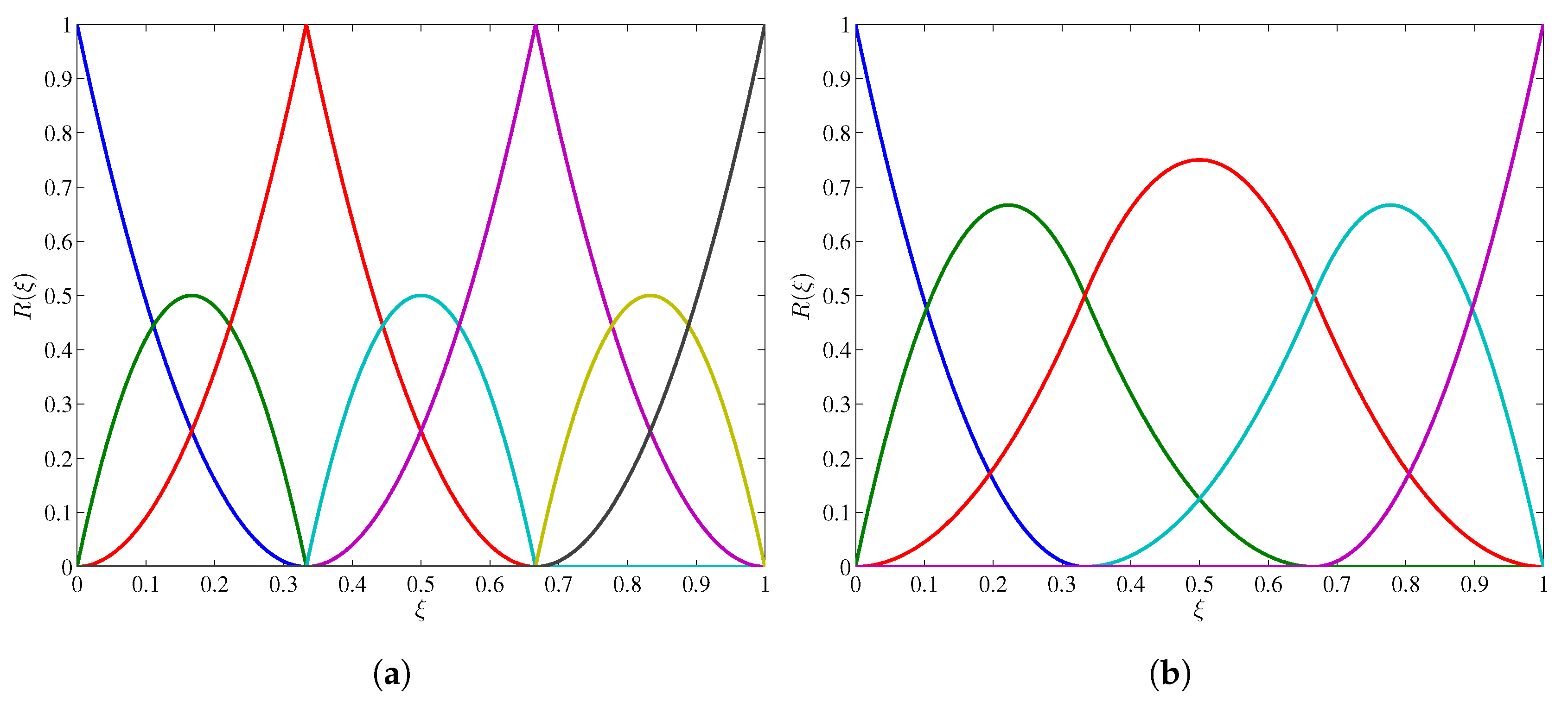
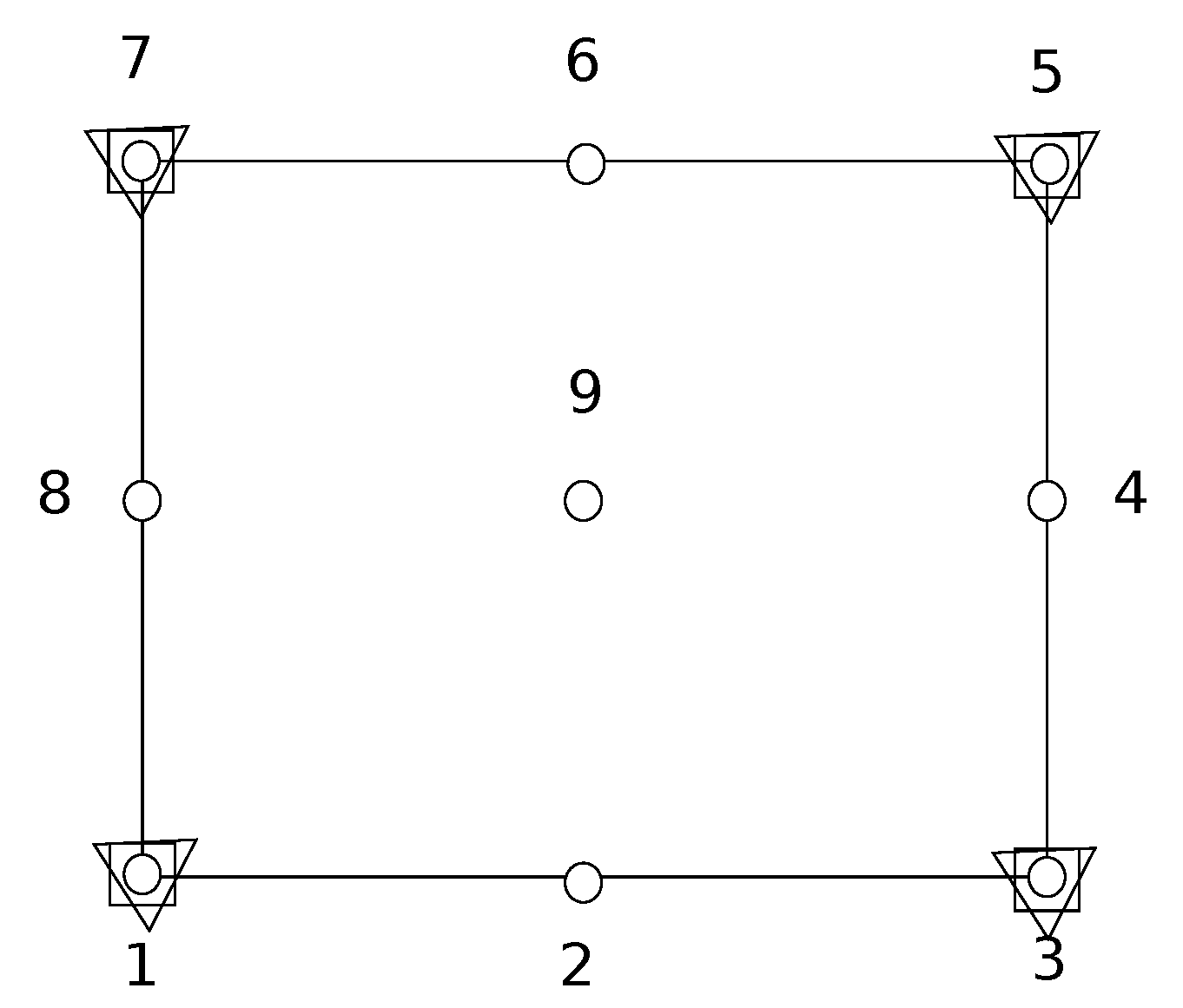
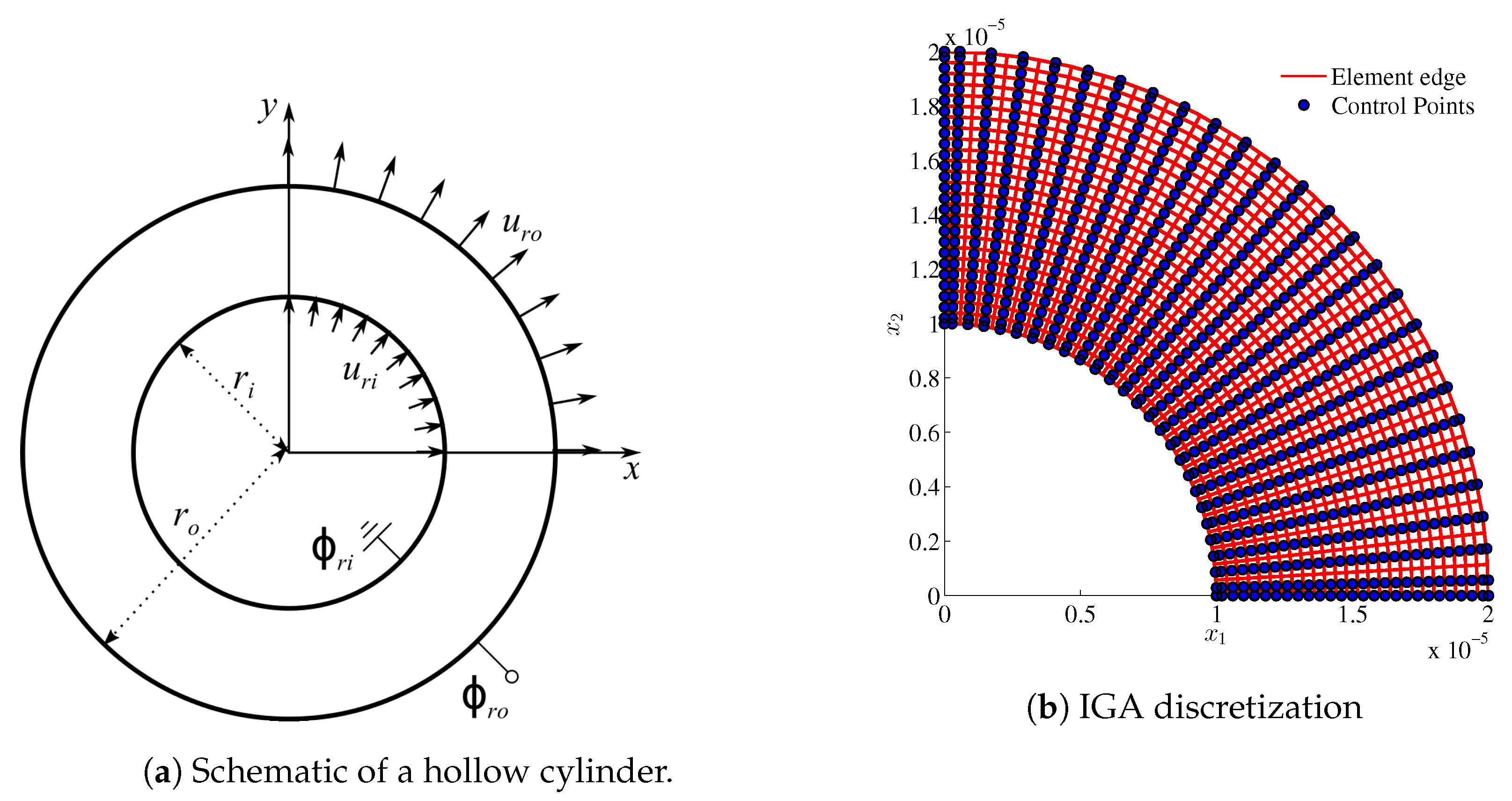




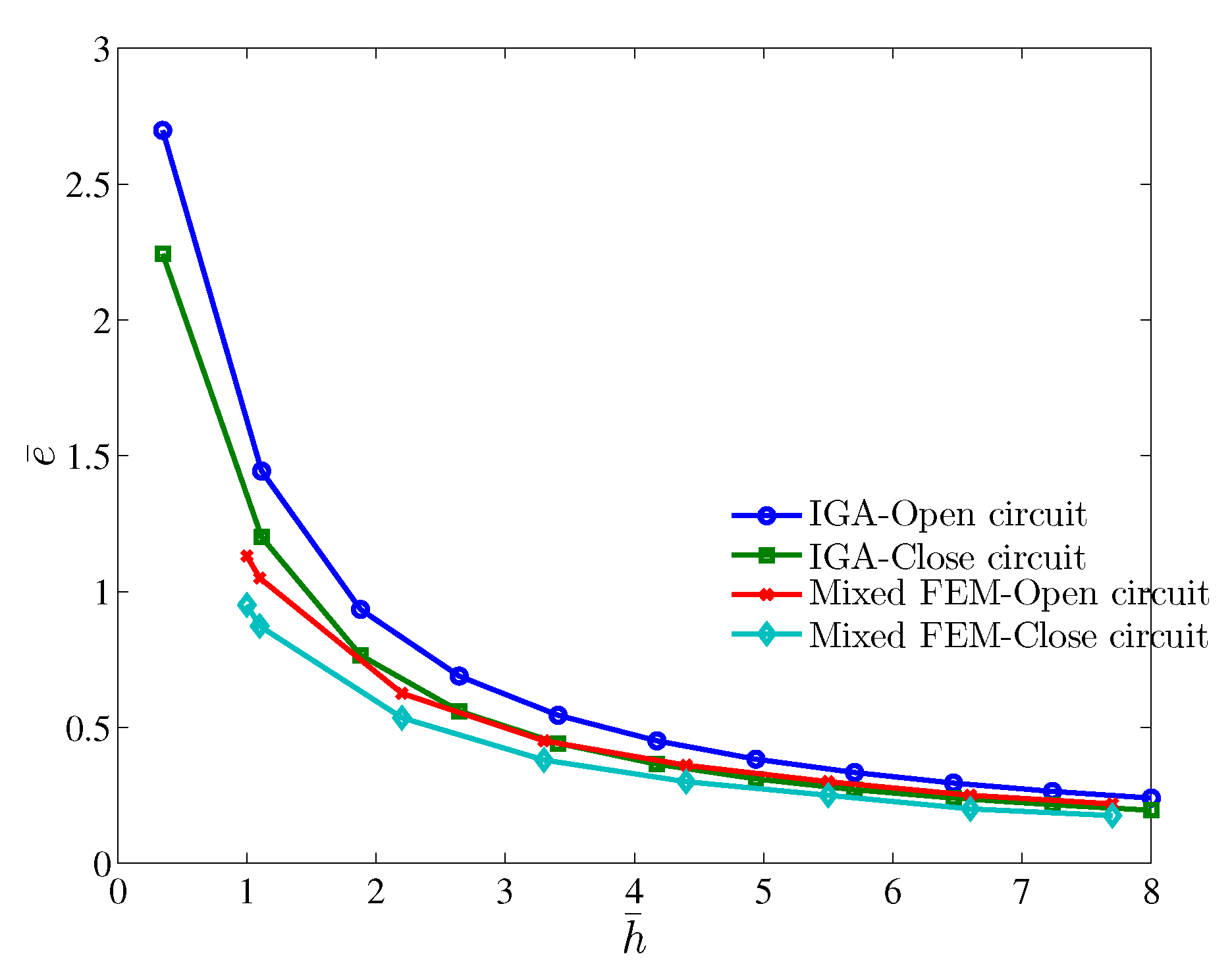
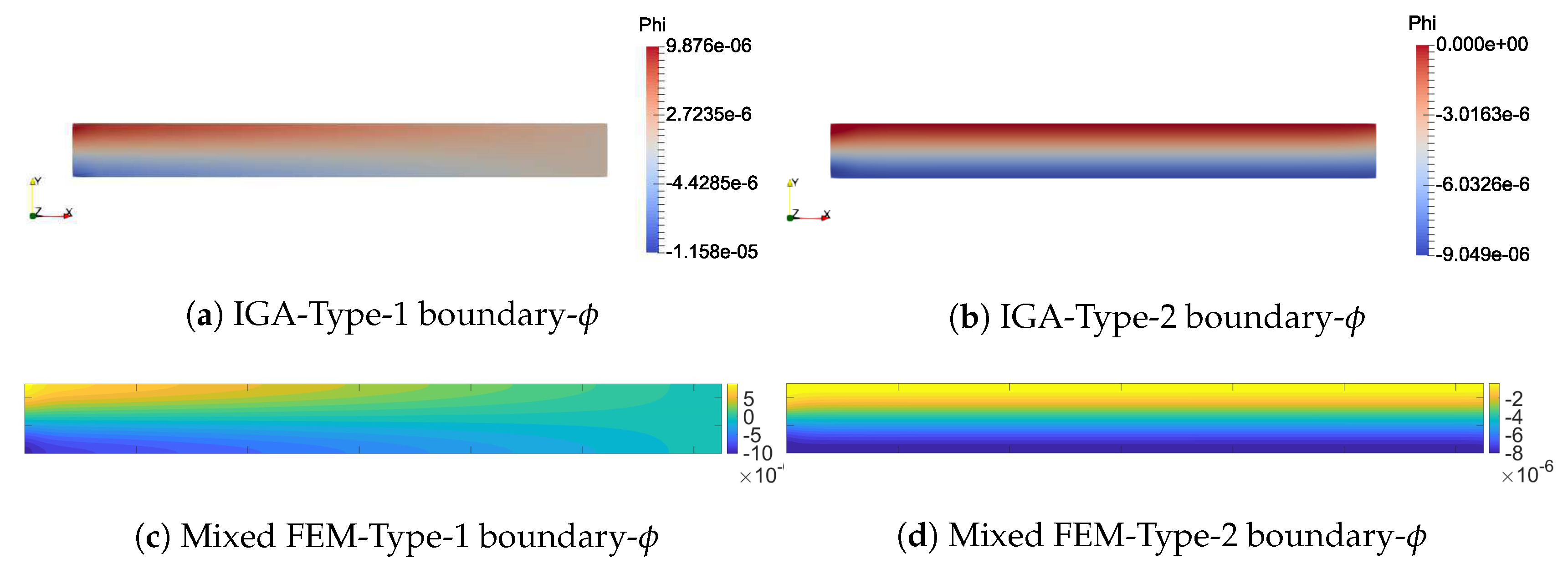

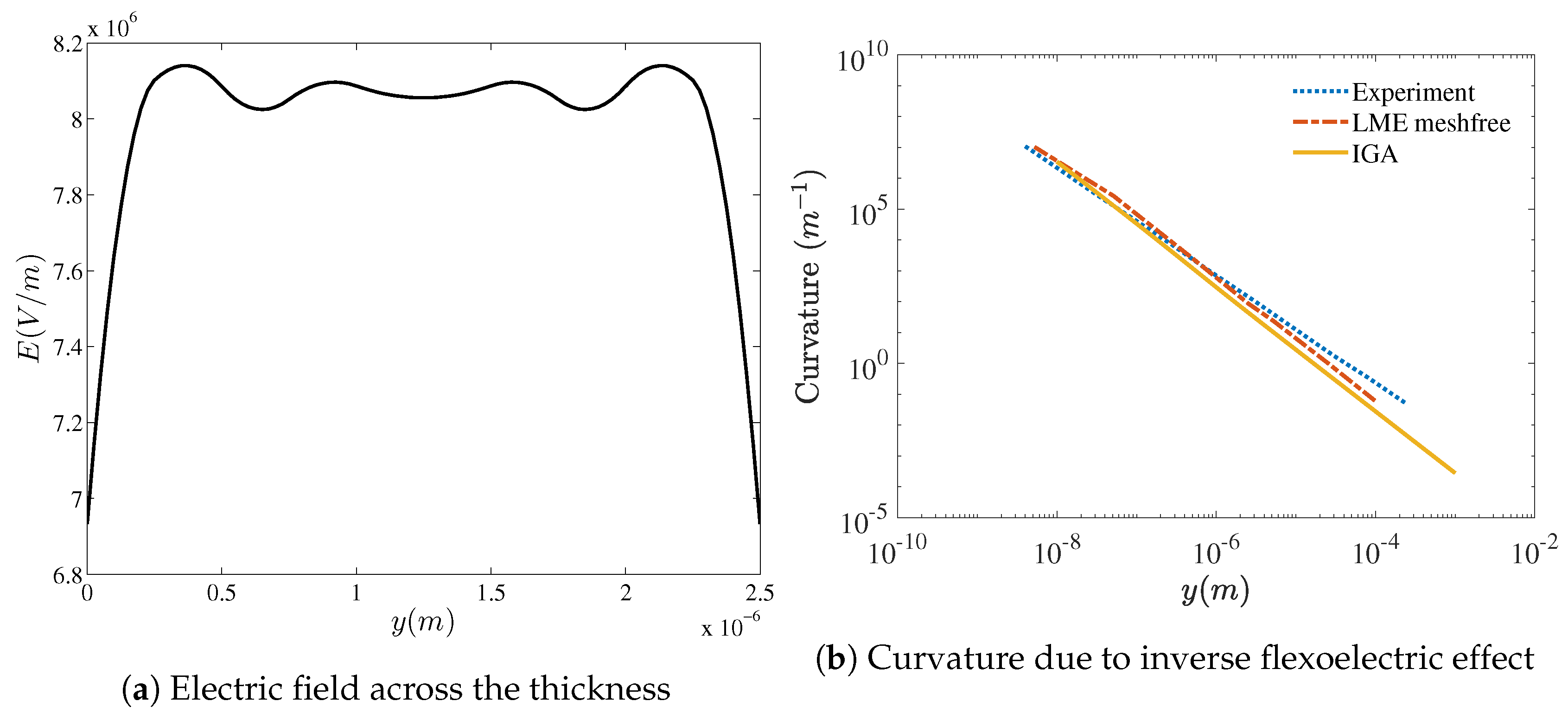
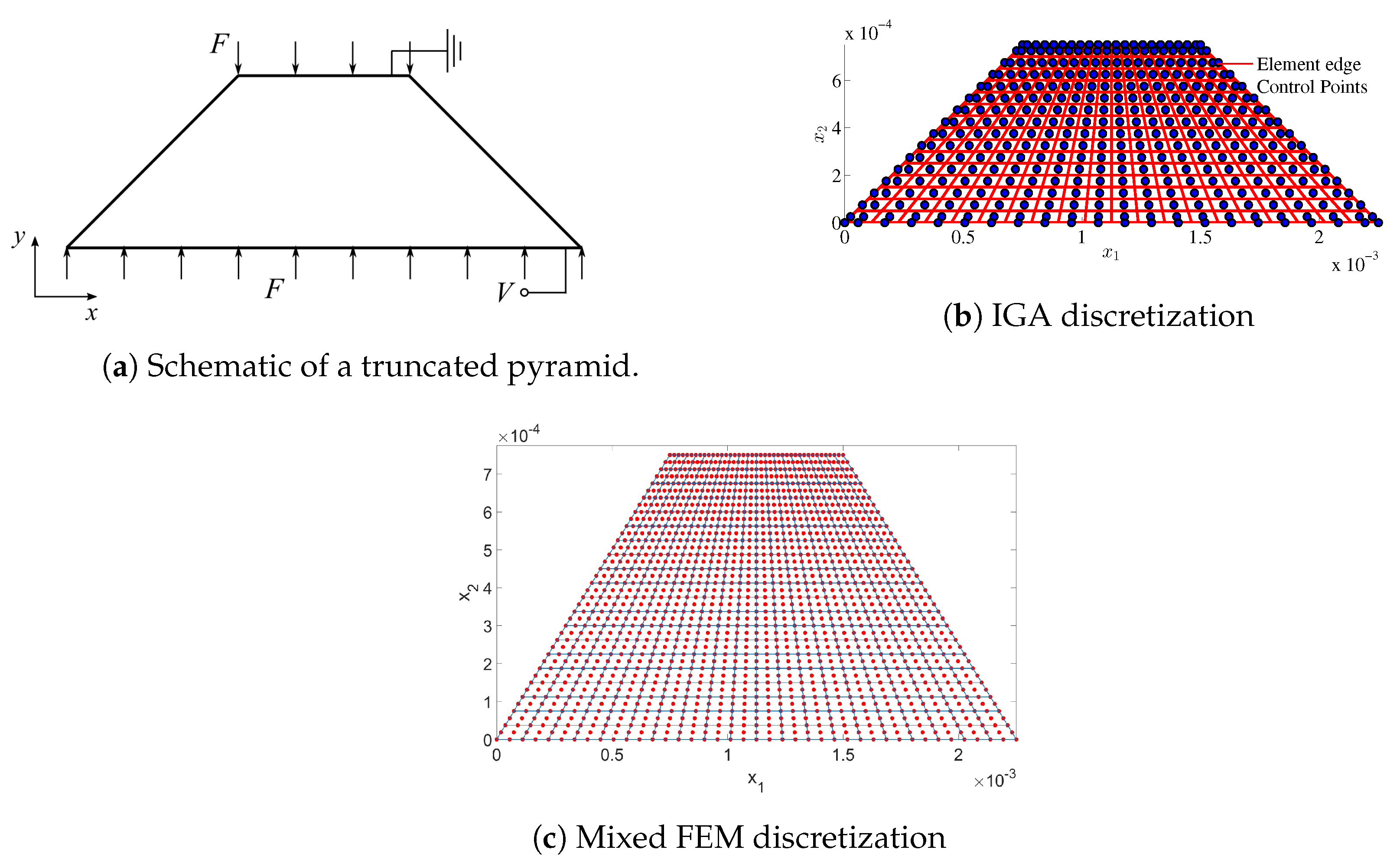



| Balance | Momentum in v | ||
| Maxwell in | |||
| Gauss law in v | |||
| Intramolecular force [24] | |||
| Gauss law in | |||
| Dirichlet BCs | Displacement on | ||
| Electric potential on | |||
| Displacement normal derivative on | |||
| Potential normal derivative on | |||
| Surface polarization on | |||
| Neumann BCs | Surface traction on | ||
| Surface charge on | |||
| Higher-order traction on | |||
| Higher-order surface charge on | |||
| Higher-order electric field on |
References [30,39] | References [38,40,43] | ||
|---|---|---|---|
| Balance | Momentum in v | ||
| Gauss law in v | |||
| Intramolecular force [24] | |||
| Gauss law in | |||
| Dirichlet BCs | Displacement on | ||
| Electric potential on | |||
| Displacement normal derivative on | |||
| Neumann BCs | Surface traction on | ||
| Surface charge on | |||
| Higher-order traction on |
| Meshfree | IGA | Mixed FEM | |
|---|---|---|---|
| Continuity | Depends on kernel functions | Knot manipulation | Nodal displacement gradient |
| D.o.f | Depends on domain of influence | 27 (a) or 108 (b) | 54 (Q54, [56]); 37 (T37), 47 (Q47), 45 (T45), 59 (Q59) [40]; 233 (3D) [57] |
| Higher-order Dirichlet BCs | - | Lagrange-multiplier | Direct imposition |
| Interface modeling | Lagrange-multiplier, Enriched functions | Multi-patch | - |
| Y | l | ||||
|---|---|---|---|---|---|
| 0.3 |
| Y | F | |||||
|---|---|---|---|---|---|---|
| 0.37 | −4.4 | 11 | 12.48 | 100 |
© 2020 by the authors. Licensee MDPI, Basel, Switzerland. This article is an open access article distributed under the terms and conditions of the Creative Commons Attribution (CC BY) license (http://creativecommons.org/licenses/by/4.0/).
Share and Cite
Zhuang, X.; Nguyen, B.H.; Nanthakumar, S.S.; Tran, T.Q.; Alajlan, N.; Rabczuk, T. Computational Modeling of Flexoelectricity—A Review. Energies 2020, 13, 1326. https://doi.org/10.3390/en13061326
Zhuang X, Nguyen BH, Nanthakumar SS, Tran TQ, Alajlan N, Rabczuk T. Computational Modeling of Flexoelectricity—A Review. Energies. 2020; 13(6):1326. https://doi.org/10.3390/en13061326
Chicago/Turabian StyleZhuang, Xiaoying, Binh Huy Nguyen, Subbiah Srivilliputtur Nanthakumar, Thai Quoc Tran, Naif Alajlan, and Timon Rabczuk. 2020. "Computational Modeling of Flexoelectricity—A Review" Energies 13, no. 6: 1326. https://doi.org/10.3390/en13061326
APA StyleZhuang, X., Nguyen, B. H., Nanthakumar, S. S., Tran, T. Q., Alajlan, N., & Rabczuk, T. (2020). Computational Modeling of Flexoelectricity—A Review. Energies, 13(6), 1326. https://doi.org/10.3390/en13061326






